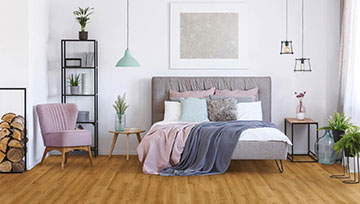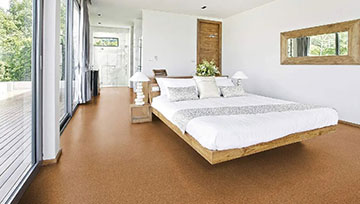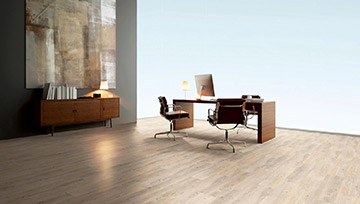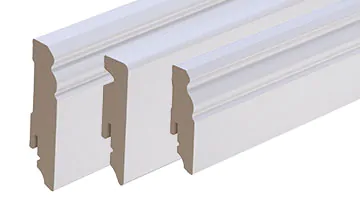Cork floor to click & glue
Cork Flooring – A Piece of Nature for Your Home. Cork flooring is the ideal choice for many customers, even though it's considered more of an exotic option. Cork is obtained from the bark of the cork oak tree. The tree is not cut down; only a part of the bark is harvested. This process can be repeated every 8 to 12 years without harming the tree. Cork is, for example, used for wine bottle corks. Cork flooring usually consists of compressed cork granules, which are derived from the leftovers of cork production used for bottle stoppers. Acrylic resins, water-based polyurethane resins, and natural resins are commonly used as binders. There are two main types of cork flooring: glue-down cork and cork parquet. Glue-down cork is fully adhered and is especially suitable for wet rooms. It is available in rolls and tiles. Cork parquet is installed using a click system. This click system is offered in various designs, depending on the manufacturer. All of them have in common the quick installation of cork flooring. However, it is not as suitable for wet rooms and for installation over underfloor heating. Continue reading here... ▼
Various Designs Available
The cork flooring is available not only in various cork patterns but also in other designs. Wood and stone are popular designs for cork flooring. Additional treatment of the surface with oil, wax, or varnish not only changes their physical properties but also the color.
Today, you can find light and dark cork flooring in almost all colors and countless designs. However, the most popular designs are still natural cork in various grain patterns and shades, wood, and stone.

What is the difference between Natural Cork and Print Cork?
As the name suggests, Natural Cork is a 100% natural product made only from cork, and its surface exhibits the classic cork appearance.
Print Cork has a layer of pollutant-free vinyl with various decors such as wood or stone applied to the cork body. This allows the positive properties of cork to be combined with almost any design.
The Advantages of Cork Flooring
- Fully recyclable, as it's a 100% natural product
- Available in various designs
- Offered for different usage classes
- Does not contain plasticizers
- Excellent thermal insulation
- High impact sound insulation of the material
- Warm underfoot
- High walking and standing comfort due to the elastic surface
- Cork is slip-resistant
- Cork is antistatic and doesn't trap dust
- The material is antibacterial
- Highly durable
- Made from a natural, renewable resource
- Joint-friendly, thanks to its elasticity
- Easy to maintain
- Fire-resistant
- Suitable for asthma and allergy sufferers
- The cork flooring is easy to repair
Disadvantages of Cork Flooring
- Cork flooring is only partially suitable for wet rooms because moisture can cause cork to expand excessively.
- Cork is not lightfast, meaning that prolonged exposure to sunlight can cause cork to fade.
- Heavy furniture can easily leave impressions on the soft surface.
- Only very thin cork floorings are suitable for installation over underfloor heating.
Cork Flooring is Extremely Environmentally Friendly
Cork flooring is not only made from a renewable resource, but its production also actively protects the environment. Cork oak forests serve as a habitat for many endangered plants and animals. These forests are preserved and even expanded because they produce a valuable resource. Cork oaks absorb CO2 while growing. This is true for all trees. BUT: By harvesting cork bark, the tree is stimulated to grow new bark, and the cork oak captures three times as much CO2 as an unharvested tree.
Sealing Cork Flooring
Natural cork floors should be sealed. They are often treated by the manufacturer accordingly. However, it is also possible to seal the cork flooring yourself. Additionally, you should reseal the flooring after several years of use.
For sealing, you have the option of using polyurethane varnish or oil/wax sealant.
Properties of Varnish Sealing
- Polyurethane varnish sealing is the most cost-effective option.
- It lasts for 5 to 10 years, depending on the floor's usage.
- Three coats are required for complete sealing.
- You can apply one coat per day.
- The sealing needs two days to dry completely.
Properties of Oil or Wax Sealing
- This sealing consists of 100% natural materials.
- It lasts for one to two years.
- Once the cork flooring has been sealed with oil or wax, polyurethane sealing cannot be applied later.
- Sealing requires two coats of oil and one coat of wax, or three coats of wax.
- After applying one coat, you need to wait for a day before applying the next coat.
- After sealing, you should polish the floor.
Sealing Cork Flooring with Polyurethane
Before sealing, you should sand the cork flooring with sandpaper to achieve a smooth surface. This prevents the flooring from absorbing too much varnish and eliminates the risk of swelling.
Afterward, thoroughly vacuum the floor. For applying the varnish, you need to use a specialized roller that is firm enough. Using a too soft roller may trap air in the applied varnish.
Sealing Cork Flooring with Oil or Wax
If you value natural materials, this sealing method is ideal. This surface treatment preserves the natural characteristics of cork and its breathable properties. The latter supports a healthy indoor environment through its balancing effect.
In the case of polyurethane sealing, this quality is lost. When applying hard oil or wax, make sure to immediately wipe away any excess. Finish the sealing process with a wax layer to make the flooring antistatic.
After applying the final coat, wait for a day before polishing the floor.
Preventing Dirt and Damage to Cork Flooring
- Avoid direct sunlight as much as possible using curtains or similar, as it can cause cork to fade.
- If something is spilled, clean it up immediately.
- Do not mop the cork flooring excessively wet.
- Do not use aggressive cleaning agents.
- Use felt gliders under furniture legs to prevent scratches.
- Place protective mats under movable furniture, such as office chairs.
- Use doormats at the entrance to trap dirt.
- Use floor mats in the sink area to catch water and splashes.
- Place plants that are on the floor on appropriate coasters.
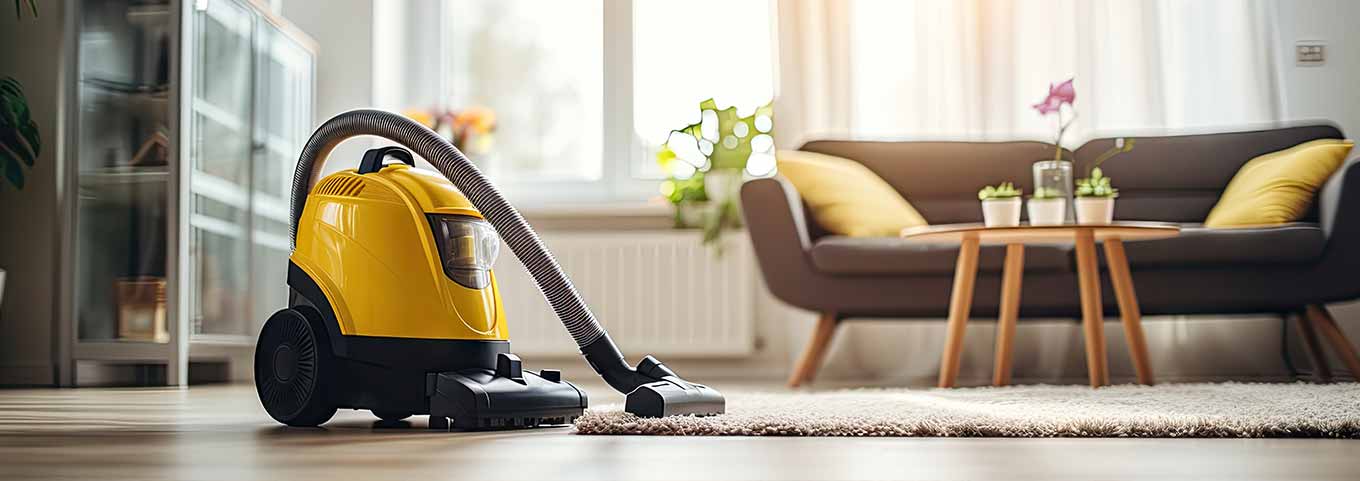
How to Clean Cork Flooring?
For daily cleaning, you only need a broom or vacuum cleaner. Depending on the usage, cork flooring should be cleaned with a damp mop two to four times per month.
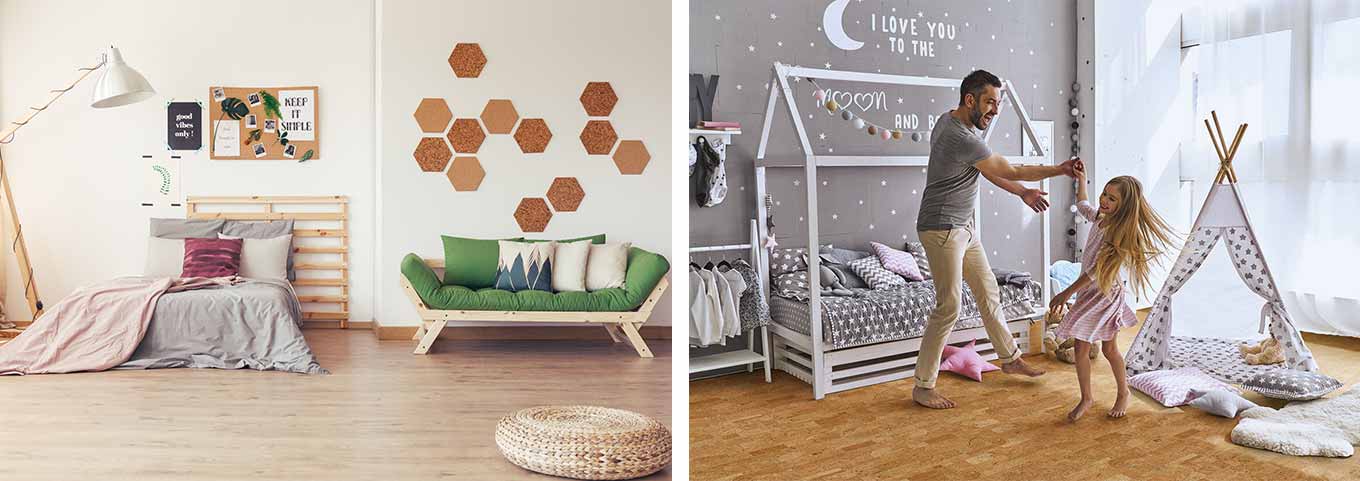
Cork Flooring with White or Natural Oil
There are natural soaps specially developed for cork. If your cork flooring is white, use "Natural Soap White"; otherwise, use "Natural Soap Natural." Using these soaps has the advantage of quickly sealing the cork's pores, protecting it from further environmental influences.
These natural soaps are applied directly to the cork flooring and then wiped off immediately with a cotton cloth. Perform this basic cleaning about once a week. The required cleaning frequency depends on the floor's usage.
For intensive cleaning, to be done every one to two months, there are special care oils available.
Apply these oils to the flooring according to the manufacturer's instructions using a cotton cloth or a paint roller. For larger areas, you can also use a polishing machine. Ensure that no oil puddles form on the floor. Work the oil into the surface and remove excess oil with a cotton cloth. Let the floor dry for 24 hours.
Sealing Cork Flooring with Hard Wax Oil
For maintenance cleaning, follow the same process as with cork flooring treated with natural oil. For maintenance, there is an oil refresher that combines a mild cleaning agent with oil care.
Before treatment, sweep or vacuum the floor to remove dust. Mix the refresher with water as per the manufacturer's instructions and mop the floor with a damp mop. Then dry the floor with a cloth and let it dry for two hours.
Sealing Cork Flooring with Ceramic Varnish
To clean cork flooring with moisture, use a common varnish or vinyl cleaner. Use two buckets for this purpose. The first one should contain the cleaner mixed as per the manufacturer's instructions.
In the second bucket, have clean water for rinsing the mop. Ensure that no water is left on the floor. For particularly stubborn stains, there is an intensive cleaner available.
For maintenance, use a varnish or vinyl maintenance product. Before using it, perform an intensive cleaning. Let the cork flooring dry completely afterward. Apply the maintenance product thinly in a single layer. You can walk on the floor again after waiting for 30 minutes.
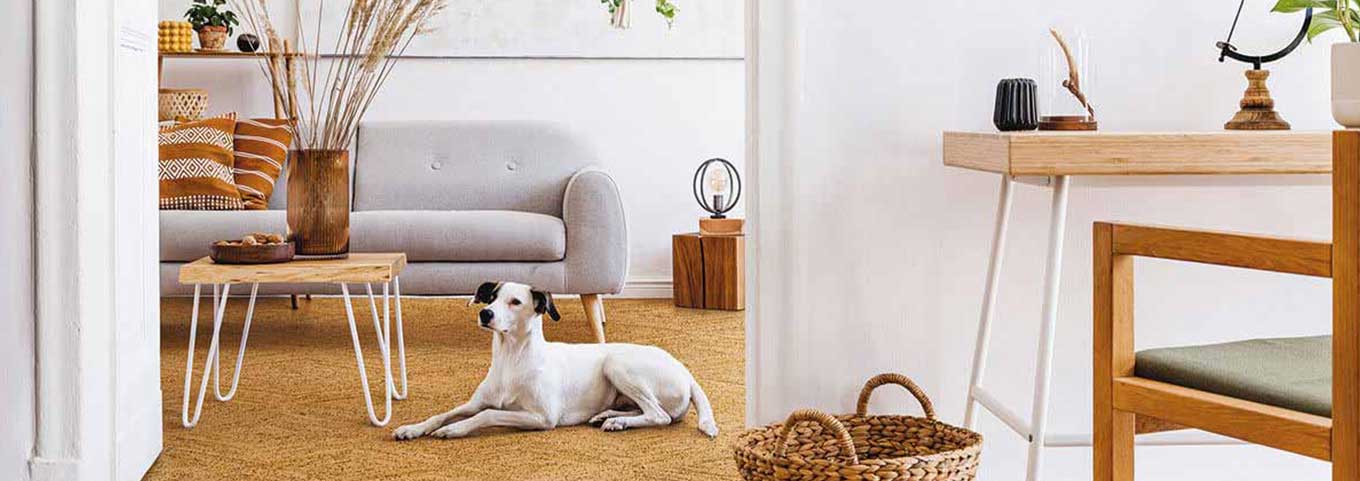
How to Properly Install Cork Flooring with Click System
If you want to install cork flooring on a screed, you need a moisture barrier, also known as a vapor barrier. This is a 0.1 to 0.2 mm thick PE film that prevents moisture from the screed from penetrating the floor covering.
You need to lay this first. Unroll the sheets with a 30 cm overlap and secure them with adhesive tape if necessary. Pull the PE film 3 cm up against the walls. This overlap, as well as the expansion joint, will be concealed by the finishing strip later.
Start the installation of cork flooring in the left room corner. Place the floor elements so that the tongue side faces the wall. Maintain a gap of 10 to 15 mm from the wall; this is the expansion joint.
You need this because cork is a natural material that expands or contracts depending on humidity. Use spacers to achieve a uniform expansion joint. Cut the last element and use the resulting remainder as the first element of the second row.
Place the elements of the second row diagonally from above against those of the first row. Push them down so that they audibly snap into place. Continue this way until the entire area is laid. Before mounting the finishing strips, remove the spacers.
Tools Needed for Installing Cork Flooring with Click System
- Saw
- Tape measure
- Pencil
- Spacers
- Possibly a drill
- Square or angle
How to Fully Adhere Cork Flooring
Using a trowel, apply adhesive to the subfloor for the first row of floor elements. Place the elements with the tongue side facing the wall and press them firmly onto the adhesive. Make sure to maintain the expansion joint.
Also, maintain an offset of approximately 40 cm from row to row. Place the individual floor elements end to end. Pay attention to the adhesive's drying time as specified by the manufacturer.
What to Consider When Buying Cork Flooring
- The cork flooring should not be too thin or too thick. If it's too thin, it may not adequately showcase its properties, such as insulation. If it's too thick, it may be too yielding, and the top layer could crack. An ideal thickness is about 3 mm.
- If the room experiences heavy use, such as a children's room, the surface should be sealed, not oiled. A sealed cork flooring is easier to clean.
Frequently Asked Questions About Cork Flooring
Question: How is cork flooring recycled?
Answer:
Cork flooring can be recycled effectively when it is free of adhesive residue, nails, or other foreign substances. It is processed into granular insulation material, which is a proven method of thermal insulation.
As loose-fill insulation with a grain size between 4 mm and 12 mm and a thermal conductivity of 0.046 W/Km, this recycling product has good building physics properties. It has a fire protection class of B2.
Question: What is cork flooring?
Answer:
Cork flooring is a natural floor covering derived from the bark of cork oak trees. The bark is harvested at regular intervals without cutting down the tree, making cork a sustainable and eco-friendly material.
Question: What are the advantages of cork flooring?
Answer:
Cork flooring offers numerous advantages, including:
- Sustainability: Cork is made from renewable resources.
- Softness and Comfort: Cork flooring is pleasantly soft underfoot and provides natural cushioning.
- Indoor Air Quality: Cork is free of harmful chemicals and allergens, improving air quality.
- Sound Insulation: Cork flooring has excellent sound-dampening properties, making it ideal for multi-unit buildings and children's rooms.
- Thermal Insulation: Cork insulates well against cold, resulting in a warm and comfortable flooring surface.
- Durability: Cork is resistant to wear and scratches, especially when sealed.
- Diverse Designs: Cork flooring is available in various colors and patterns to complement different interior styles.
Question: What rooms is cork flooring suitable for?
Answer:
Cork flooring is suitable for a variety of rooms, including:
- Living rooms
- Bedrooms
- Nurseries
- Offices
- Kitchens
Question: How is cork flooring installed?
Answer:
Cork flooring can be installed as a floating floor or glued, depending on the manufacturer's instructions and spatial conditions. Professional installation is recommended to achieve the best results.
Question: How to care for cork flooring?
Answer:
Caring for cork flooring is simple. It can be cleaned with a damp mop and a cork-compatible cleaning solution. However, avoid excessive moisture as it can damage the material.
Question: Is cork flooring suitable for allergy sufferers?
Answer:
Yes, cork flooring is an allergy-friendly option as it is naturally free from harmful chemicals and allergens. It contributes to improved air quality and is a great choice for allergy-sensitive individuals.
Question: How sustainable is cork as a flooring material?
Answer:
Cork is highly sustainable as cork oak trees can be harvested every nine to twelve years without harming the tree. This makes cork an eco-friendly material that preserves forests and minimizes environmental impact.
Question: What experiences have users had with cork flooring?
Answer:
For the sealing of cork floor covering, solvent-based products should not be used. Waxes, oils, natural resins, and water-based paints have a more pleasant smell or are odorless. You should consider these cork flooring experiences of other users to enjoy your new cork floor covering for a long time.
Cork flooring is an excellent choice for those seeking a natural, comfortable, and sustainable flooring option. With its numerous advantages, cork is an attractive flooring option for various rooms and interior styles.

